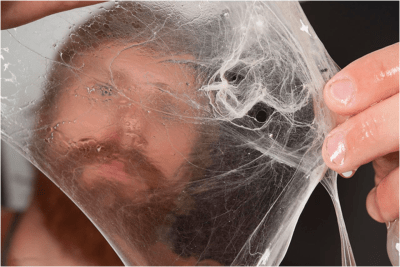In the cold, dark recesses of ocean floors around the world, hagfish slither around like sea snakes, searching for food. When a hagfish finds a suitable carcass, it devours the dead fish in two different ways. As it burrows face-first through the tissue, eating with its jaw-less, tentacled mouth, the hagfish also absorbs nutrients through its skin.
Hagfish are not the unholy result of dumping toxic waste in the ocean. They’re one of the oldest creatures on Earth, having been around for more than 300 million years. How have they lasted this long?

These ancient creatures have no eyes, no backbones, and no scales. They are often misidentified as eel, and often called ‘slime eels’, but they are definitely fish. They just don’t look like conventional fish. In fact, when conventional, gill-faced fish come after hagfish, those guys are in for a surprise, because hagfish have a disgusting but ingenious defense mechanism.
Whenever hagfish are attacked or even just stressed by nearby fish or curious grabby humans, they immediately emit amazing amounts of mucus at an alarming rate. At the same time, the hagfish shoots out silky strands of protein that hold the slime together in a cohesive blob. Any predator that tries to bite down on one of these velvety frankfurters of the deep sea will find its mouth and gills covered in a wad of suffocating slime.
How is it that hagfish haven’t slimed themselves out of existence? Whenever they get get a taste of their own medicine, these boneless noodles quickly twist themselves into a pretzel. In the same motion, they use their paddle-shaped tails to squeegee off the slime.
Silky, Sustainable Slime
One of the most interesting things about hagfish slime is its composition. The structure of hagfish slime is 99.996% water, and it has some interesting properties that could lead to different kinds of sustainable resources. But that’s only if scientists are able to replicate it. Hagfish can’t really be farmed because they don’t breed in captivity. Not much is known about their reproductive habits at all.

Hagfish slime is made of two different kinds of protein. One is a type of mucin, which acts much like the mucus that the human body uses to drown bacteria and viral intruders in antibodies and enzymes.
The other protein is in the form of tiny threads that are 100 times thinner than human hairs. These strong and stretchy threads act a lot like spider silk. As soon as the hagfish releases the goods, the mucin absorbs water and the protein threads get entangled with each other, creating a soft, stretchy slime.
Researchers believe these threads could potentially replace fossil fuel-based products like nylon and other synthetic materials. The threads are ten times stronger than nylon, so they could potentially be used in bulletproof vests and other protective equipment.
These threads are so thin that they make hagfish slime one of the softest materials known to man. Your most comfortable t-shirt has nothing on a shirt made from hagfish threads. Hagfish active wear would be more than next level.
Because hagfish slime absorbs water so rapidly and thirstily, some scientists believe it could be used to make super hydrogels for everything from disposable diapers to tissue engineering. We like to imagine cars with hagfish slime airbags, or big bags of dehydrated hagfish slime being used to absorb floodwater. What else do you think this stuff could be used for?
Thread Management in Hagfish
At any given time, a hagfish has about 20,000 km of fibers inside its body, ready to go. This incredible feat of organization requires a pretty phenomenal storage method. Each thread grows inside its own cell, called a gland thread cell. It begins life as a wild, wiggly wisp wedged between the upper wall of its cell and a large nucleus that takes up most of the cell. As the thread matures and grows longer, it lays itself in neat vertical loops around the nucleus.

Over time the nucleus shrinks and stretches into a spike, settling at one end of the cell to act like a spindle. As the nucleus gets longer, so do the vertical loops of thread. A mature thread measures about six inches (15 cm) long, but it’s packed inside a cell that’s only about 1/10th of a millimeter long. All of this adaptation allows the cell to organize the 15-20 layers of thread into a single untangled skein that’s ready to spring forth and spread out into the slime.
For an ancient creature, the hagfish displays an incredible amount of biological precision. They are eaten as a delicacy in Korea, and their soft skin has been made into handbags and wallets since WWII. Elsewhere, they are largely ignored. As of 2011, the different hagfish species are facing various levels of endangerment. Hopefully, they won’t slip out of our hands entirely before we can figure out their secrets.
No comments:
Post a Comment